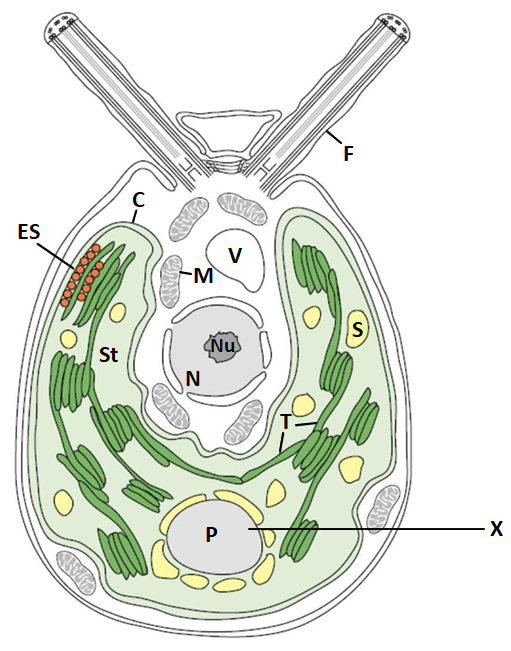Rather than having true roots, stems and leaves the members of Phaeophyceae have root like holdfast, stem like stipe and leaf like fronds. What will be true for these structures?
I. Holdfasts are not the primary organs for water and nutrient uptake.
II. In brown algae like Fucus, the tissues in stipe include a central pith, a surrounding cortex and an outer epidermis.
III. Gas filled floats called pnematocysts provide buoyancy in many brown algae.
1. I and II only
2. I and III only
3. II and III only
4. I, II and III
II. In brown algae like Fucus, the tissues in stipe include a central pith, a surrounding cortex and an outer epidermis.
III. Gas filled floats called pnematocysts provide buoyancy in many brown algae.
2. I and III only
3. II and III only
4. I, II and III
What would be true for the structure labeled with letter ‘X’ in the given diagram showing the ultrastructure of Chlamydomanas?
1. It is the region of the chloroplast where circular DNA is present
2. It is associated with the operation of a carbon-concentrating mechanism (CCM)
3. It is the inclusion body with accumulated toxic wastes for elimination
4. It is filled with air and is responsible for buoyancy of the organism
The diagram shows a sorus in section in ferns. What would be the name for A?
1. Annulus
2. Placenta
3. Indusium
4. Stomium
In the given longitudinal section of archegonium of moss identify A, B, C and D respectively:
1. Ventral canal cell, Neck canal cell, Egg, Venter
2. Ventral canal cell, Neck canal cell, Venter, Egg
3. Neck canal cell, Ventral canal cell, Venter, Egg
4. Neck canal cell, Ventral canal cell, Egg, Venter
Consider the given two statements:
I. The term ‘embryophytes’ is an appropriate synonym for plants.
II. The occurrence of a multicellular, matrotrophic embryo in plants from bryophytes through angiosperms.
1. Both I and II are correct and II explains I
2. Both I and II are incorrect but II does not explain I
3. I is correct but II is incorrect
4. Both I and II are incorrect
Consider the two trends in evolution of plants:
I. A reduction of vascular tissues occurs from gymnosperms and woody dicots to herbaceous dicots to monocots
II. The gametophytes of vascular plants have become smaller and simpler
1. Both I and II are correct
2. Only I is correct
3. Only II is correct
4. Both I and II are incorrect
The seed of a gymnosperm is a complex structure with three generations locked up in it. Identify the correct match:
I. Female gametophyte: Old generation
II. Seed coat: Present generation
III. Embryo: Future generation
1. Only I
2. Only III
3. Only I and II
4. Only II and III
The description of which of the following features of reproductive structures of Funaria is correct?
I. Reproductive organs are borne on separate branches of the same thallus
II. Antheridia are club shaped
III. Archegonia are flask shaped
1. I and II only
2. I and III only
3. II and III only
4. I, II and III
All the following regarding Dryopteris are true except:
1. Involute vernation
2. Obliquely growing subterranean rhizome
3. Large compound leaves called fronds
4. Hair like ramenta covering petiole
In Cycas:
I. Micro sporophylls bear two elongated sac like structures at the base on the ventral side called pollen sacs.
II. Pollen grains are winged.
III. Megasporophylls are compact when young but spread apart when mature.
IV. Each megasporophyll has (a) bract scale and (b) ovuliferous scale which bears 2 ovules on the ventral side.
1. Only I, II and III are correct
2. Only I, III and IV are correct
3. Only II, III and IV are correct
4. I, II III and IV are correct






